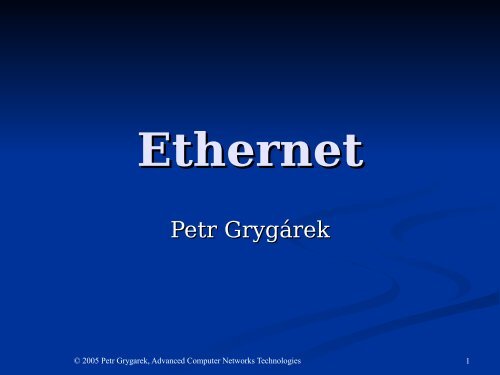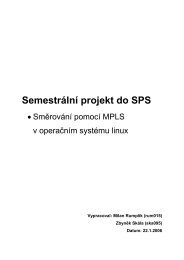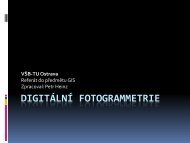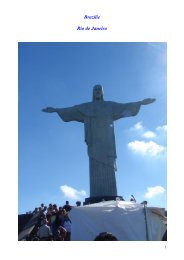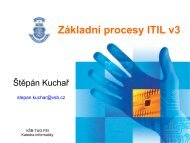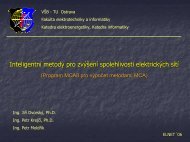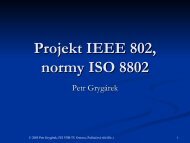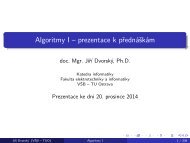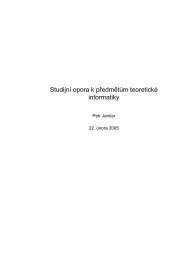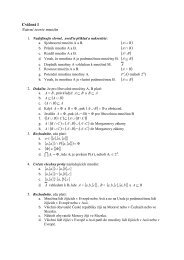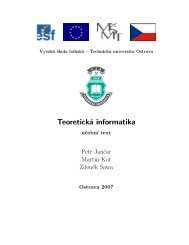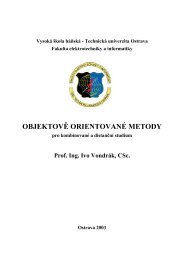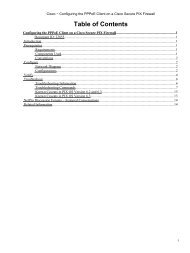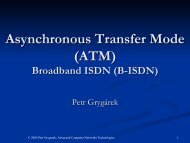Cisco Presentation Guide
Cisco Presentation Guide
Cisco Presentation Guide
Create successful ePaper yourself
Turn your PDF publications into a flip-book with our unique Google optimized e-Paper software.
Ethernet<br />
Petr Grygárek Gryg rek<br />
© 2005 Petr Grygarek, Advanced Computer Networks Technologies 1
Ethernet History Histor<br />
•Research Research background: AlohaNet<br />
•University University of Hawai, 1970: 1970:<br />
common (radio) channel<br />
sharing methods – basis for CSMA/CD<br />
•1980: 1980: DIX published Ethernet standard<br />
(Metcalfe)<br />
•1985: 1985: IEEE 802.3 802.3<br />
(MAC and LLC layers)<br />
•10Base5, 10Base5, 10Base2, 10BaseT<br />
•1995 1995 IEEE 802.3u (Fast Ethernet)<br />
•1998 1998 IEEE 802.3z (Gigabit Ethernet)<br />
•2002 2002 IEEE 802.3ae (10Gb Ethernet)<br />
•... ...<br />
© 2005 Petr Grygarek, Advanced Computer Networks Technologies<br />
2
Ethernet Naming Rules<br />
(IEEE Standard)<br />
Mbps [Base|Broad] [segment_length<br />
[segment_length_m<br />
_m | -medium] -medium<br />
-T T - Twisted Pair, -F F - Fiber optic, ...<br />
e.g. 10Base5, 10BaseT, 100BaseF<br />
Name of each particular Ethernet<br />
technology defined in individual<br />
supplements supplement of 802.3 standard<br />
•e.g e.g 802.3u, 802.3ab, 802.3z<br />
© 2005 Petr Grygarek, Advanced Computer Networks Technologies<br />
3
Half-duplex and Full-duplex<br />
Ethernet<br />
•Half Half duplex – colission envirnment<br />
(CSMA/CD)<br />
•Full Full duplex - colission-free<br />
(switched) environment<br />
In half-duplex mode we have to adhere CSMA/<br />
CD timing that implies the maximum cable<br />
lengths<br />
For compatibility with half-duplex NICs, P2P<br />
links may also operate in half-duplex mode<br />
© 2009 Petr Grygárek, FEI VŠB-TU Ostrava, Computer Networks (Bc.)<br />
4
Historical Ethernet<br />
Implementations<br />
© 2005 Petr Grygarek, Advanced Computer Networks Technologies<br />
5
10Base5<br />
= Thick Ethernet = DIX Ethernet =<br />
ETHERNET II<br />
© 2009 Petr Grygárek, FEI VŠB-TU Ostrava, Computer Networks (Bc.)<br />
6
10Base5 Capabilities<br />
•Bus Bus (coax) „Yellow Cable“<br />
•50ohm, 50ohm, diameter of 10 mm<br />
•Max Max segment length 500m, terminated<br />
•Max Max 5 segments interconnected by 4 repeaters,<br />
stations may be placed only on 3 segments (5-4-3<br />
rule)<br />
•Max Max 100 stations per segment, minimum distance<br />
of 2.5 m<br />
•Manchester Manchester encoding<br />
•Utilizes Utilizes external transceivers (AUI interface)<br />
•Attached Attached to bus by T-connector or wampire tap<br />
© 2009 Petr Grygárek, FEI VŠB-TU Ostrava, Computer Networks (Bc.)<br />
7
10Base2<br />
= Thin Ethernet = CheaperNet<br />
•bus, bus, coax RG58<br />
•50ohm, 50ohm, diameter of 5 mm)<br />
•Max Max segment length 185m, terminated<br />
•5-4-3 5-4-3 rule<br />
•Max Max 30 stations per segment, minimum<br />
distance 0.5m<br />
•Interconnection: Interconnection: BNC and T<br />
connectors<br />
•Transceiver Transceiver is integrated on the NIC<br />
© 2009 Petr Grygárek, FEI VŠB-TU Ostrava, Computer Networks (Bc.)<br />
8
10BaseT<br />
•Star Star (tree) topology<br />
•2 2 twisted pairs (UTP3) + RJ-45 connectors<br />
•May May operate in full-duplex mode when switches<br />
are applied<br />
•Stations Stations interconnected with hubs<br />
•5-4-(3) 5-4-(3) rule<br />
•max. ax. 512 stations in the whole tree<br />
•Max Max 100m between hub and NIC<br />
•min min 0.6m<br />
•Crossing Crossing of transmitter and receiver<br />
cable pairs<br />
© 2009 Petr Grygárek, FEI VŠB-TU Ostrava, Computer Networks (Bc.)<br />
9
Fast Ethernet (100Mbps)<br />
•IEEE IEEE 802.3u<br />
•Based Based on 10BaseT<br />
•the the same MAC address protocol and<br />
frame format<br />
•NICs NICs are obviously backward compatible with<br />
10BaseT<br />
•Speed Speed autonegotiation capability<br />
•different different line encoding<br />
•Uses Uses UTP5, 100m between network<br />
devices<br />
© 2009 Petr Grygárek, FEI VŠB-TU Ostrava, Computer Networks (Bc.)<br />
10
Physical Layer of Fast<br />
Ethernet<br />
•100BaseTX: 100BaseTX: UTP5, STP – UTP5, max<br />
100m, 4B5B + MLT3, 125 MHz<br />
•100BaseFX: 100BaseFX: FO, max. distance NICNIChub is 200m (because of CSMA/CD)<br />
•Other Other sparsely used options<br />
•Developed Developed for compatibility with older<br />
cablings - 100BaseT2, 100BaseT4<br />
© 2009 Petr Grygárek, FEI VŠB-TU Ostrava, Computer Networks (Bc.)<br />
11
Fast Ethernet Topologies<br />
(half-duplex)<br />
•2 2 directly connected NICs<br />
•Star Star with Class I hub<br />
•Two Two Class II hubs interconnected by line<br />
of maximum 10 m in length<br />
Hub class I and II differ in<br />
•Maximum Maximum allowed signal delay<br />
•Capability Capability of encoding transformation, i.e. the<br />
ability of using different media in a single<br />
collision domain<br />
•e.g. e.g. transformaiton of 100BaseTX to 100BaseT4<br />
© 2009 Petr Grygárek, FEI VŠB-TU Ostrava, Computer Networks (Bc.)<br />
12
Ethernet Today<br />
•Ethernet Ethernet today is a whole family of<br />
networking technologies (100Mbps+)<br />
•LAN, LAN, MAN, WAN<br />
•Compatibility Compatibility still maintained<br />
© 2005 Petr Grygarek, Advanced Computer Networks Technologies<br />
13
Gigabit Ethernet (802.3z)<br />
•Developed Developed since 1995, originally supposed<br />
to require fiber optic or coax cable,<br />
standard later extended for twisted pair<br />
•802.3ab 802.3ab – compatible with existing wirings<br />
(Cat5e)<br />
•Makes Makes the standard Ethernet faster again<br />
• CSMA or switching, IEEE 802.3 frame, simple<br />
star topology<br />
•Problems Problems with minimum frame length in<br />
collision-mode when trying to keep the<br />
same maximum cable lengths as with<br />
10BaseT<br />
•Appends Appends a padding to 512B into a frame if<br />
necessary or applies packet bursting.<br />
• Most commonly used for backbone links<br />
© 2009 Petr Grygárek, FEI VŠB-TU Ostrava, Computer Networks (Bc.)<br />
14
Physical Layer of the Gigabit<br />
• 1000Base-T: UTP5e<br />
Ethernet<br />
• All 4 pairs used simultaneously in both directions<br />
(PAM5, echo cancellation), max. 100m<br />
• Problems with reflections connectors (the cabling<br />
system may start to resonate)<br />
• 1000Base-SX (short wavelength-850 nm) – used<br />
more often<br />
• 8B10B encoding<br />
• 62.5 um MMF 440m, 50 um MMF 550m<br />
• 1000Base-LX (long wavelength-1300 nm)<br />
• 8B10B encoding<br />
• SMF 3 km, 62.5 um MMF 440m, 50 um MMF 550m.<br />
• Usage of „offsets“ to limit transversal modes on MMF<br />
(decreases dispersion)<br />
• ANSI Fibre Channel<br />
• Supports bandwidths of 133Mpbs to 1Gbps on various<br />
cable types (MMF, STP, coax)<br />
© 2009 Petr Grygárek, FEI VŠB-TU Ostrava, Computer Networks (Bc.)<br />
15
1000BaseX (802.3z ( 802.3z): : Fiber Optics<br />
•extends extends the original LAN technology to<br />
distances that make Ethernet a WAN/MAN<br />
standard<br />
•1000BASE-<br />
1000BASE-SX SX<br />
•850nm 850nm laser/LED, laser/LED,<br />
MM fiber, SC – low cost<br />
•distances distances 220-550m (better better for 50/125 than 62.5/50<br />
fiber) fiber)<br />
•1000BASE-<br />
1000BASE- LX<br />
•1310nm 1310nm laser SM fiber (5km) or MM fiber (500m), (500m) ,<br />
SC<br />
•8B10B+NRZ 8B10B+NRZ ("level-driven") encoding<br />
•Some Some bit combination have alternative 8B10B<br />
codewords<br />
•chosen chosen dynamically to reach balanced bit pattern<br />
•Because Because of high rate,1s rate, s and 0s 0 encoded with low and<br />
high power instead of presence/absence of light<br />
© 2005 Petr Grygarek, Advanced Computer Networks Technologies<br />
16
1000BaseT (802.3ab)<br />
• uses TP Category 5e or higher<br />
• cat5e at5e allows 125Mbps<br />
• all four pairs, 125 Mbd each<br />
• 4D-PAM5 line encoding<br />
• pulse amplitude modulation, 5 states<br />
•2bits/symbol 2bits/symbol + Forward Error Correction (8-state ( 8-state Trellis<br />
code)<br />
• control and data symbols<br />
•250 250 Mbps/pair if 125 Mbd used<br />
• 4x in parallel (for each pair)<br />
• See http://www.reed<br />
electronics.com/tmworld/article/CA287078.html<br />
• Full ull duplex: duplex:<br />
echo cancellation, cancellation,<br />
on all pairs<br />
• 9 voltage levels in idle periods, 17 during data<br />
transmission<br />
• need to synchronize clocks (clock master elected)<br />
• probl roblems ems with reflections (danger of resonance)<br />
© 2005 Petr Grygarek, Advanced Computer Networks Technologies<br />
17
Ethernet in Depth<br />
© 2005 Petr Grygarek, Advanced Computer Networks Technologies<br />
18
Ethernet Advantages<br />
•Simplicity<br />
Simplicity<br />
•lower lower learning and implementation cost<br />
•preferred preferred over (more sophisticated) FDDI,<br />
ATM etc.<br />
•Scalability<br />
Scalability<br />
•maintains maintains the same frame format at all<br />
transfer rates<br />
•Compatibility<br />
Compatibility<br />
•frame frame format (including MAC address format)<br />
•CSMA/CD CSMA/CD (until ( until 1000Base-T)<br />
1000Base T)<br />
•Modularity<br />
Modularity<br />
•Only Only physical layers differs<br />
© 2005 Petr Grygarek, Advanced Computer Networks Technologies<br />
19
Legacy Ethernet:<br />
Common Characteristics<br />
•10Base5-1980, 10Base5-1980, 10Base2-1985,<br />
10BaseT-1990<br />
•Timing Timing parameters (100ns bit timeslot,<br />
51.2us slot time)<br />
•Frame Frame format<br />
•Transmission Transmission processes<br />
•Manchester Manchester encoding<br />
•CSMA/CD CSMA/CD (half duplex)<br />
•full full duplex defined later for 10BaseT (1997)<br />
•Basic Basic design rule (5-4-3)<br />
•No No more than four repeaters can be used in<br />
series between any two stations. There can<br />
also be no more than three populated<br />
segments between any two stations.<br />
© 2005 Petr Grygarek, Advanced Computer Networks Technologies<br />
20
Ethernet Frame<br />
•Preamble: Preamble: 7x 10101010, 1x 10101011 (SFD)<br />
•necessary necessary only for (asynchronous) 10Mbps Ethernet<br />
•Type Type
802.1q Frame Header<br />
•extra extra 2+2 bytes (priority, VLAN ID)<br />
•Inserted Inserted behind TYPE field<br />
•Indicated Indicated by TYPE=8100h<br />
•Original Original TYPE repeated just behind<br />
802.1q header<br />
© 2005 Petr Grygarek, Advanced Computer Networks Technologies<br />
22
Timing<br />
•Propagation Propagation delay (UTP): (UTP) : 20.3 cm/ns,<br />
•100m 100m UTP = 5 bit times (10Mbps)<br />
•Slot Slot time = minimum mi um frame duration<br />
•512bit 512bit times (64B ( 64B) ) for 10 and 100 Mbps bps<br />
Ethernet<br />
•4096 4096 bit time time<br />
slots (512 B) for 1000 Mbps Mbps<br />
•calcula calculated ed assuming maximum maximu cable lengths<br />
(and repeater delay)<br />
•max max delay defined as 51,2 micro mi roseconds seconds<br />
•32bit 32bit “jam jam” signal<br />
•Interframe Interframe spacing 96 bit timeslots timeslots<br />
•time time that allows receiver(s) to process frame<br />
and prepare for another frame reception<br />
© 2005 Petr Grygarek, Advanced Computer Networks Technologies<br />
23
Timing Considerations<br />
for Mixed-media Network Design<br />
•Cable Cable length<br />
•Velocity Velocity of signal propagation<br />
•Transceiver Transceiver delay<br />
•Repeater Repeater delay<br />
•Interframe Interframe gap shrinkage due to<br />
repeaters<br />
•repeater repeater is expected to regenerate all 64 bits<br />
of preamble, despite the potential loss of some<br />
of the strarting preamble bits because of slow<br />
synchronization<br />
•this his forced reintroduction of timing bits<br />
reduces original interframe gap<br />
•Processing Processing delay in station NIC’s CPU<br />
© 2005 Petr Grygarek, Advanced Computer Networks Technologies<br />
24
Collisions<br />
•When hen a transmitting station detects a<br />
collision, it stops sending it's frame and<br />
sends 32bit Jam sequence to announce<br />
collision to other stations<br />
•jam jam signal may be composed of any binary<br />
data that do not form the proper checksum for<br />
the portion of the frame already transmitted<br />
•most most commonly 101010…<br />
•The The majority of collisions occurs occur very<br />
early in the frame, often before the SFD<br />
•Collision Collision fragments = frames
Collision Detection<br />
•Coax: Coax: amplitude of the signal on the<br />
network media increases<br />
•Manchester Manchester characteristics:<br />
number of High level intervals =number<br />
of Low level intervals, average should<br />
be 0<br />
•If If two Manchester waveform mix,<br />
average level moves<br />
•waveform waveform can be smoothed and level<br />
measured on capacitor<br />
•UTP: UTP: signal on RX pair while<br />
transmitting on TX pair<br />
© 2005 Petr Grygarek, Advanced Computer Networks Technologies<br />
26
•Local Local collision<br />
Collision Types<br />
•simultaneous simultaneous transmission of multiple stations<br />
on the same coaxial segment, detected as<br />
amplitude increase (signal “sums up” on<br />
terminators)<br />
•Remote Remote collision<br />
•collision collision behind repeater<br />
•cannot cannot be detected by amplitude increase<br />
(repeater will not pass it) or by simultaneous<br />
signal on RX and TX pair<br />
•identified identified by presence of collision fragment<br />
(short frame with wrong CRC)<br />
© 2005 Petr Grygarek, Advanced Computer Networks Technologies<br />
27
Late Collision<br />
•Collision Collision out of the timeslot (after<br />
first 64B) 64B<br />
•NIC NIC will not repeat the transmitted<br />
frame<br />
© 2005 Petr Grygarek, Advanced Computer Networks Technologies<br />
28
Bit Synchronization<br />
•10Mbps: 10Mbps: synchronizes before every<br />
frame independently using preamble<br />
(“asynchronous Ethernet”)<br />
•faster faster versions: synchronization<br />
always maintained<br />
•using using reserved “idle” symbols<br />
© 2005 Petr Grygarek, Advanced Computer Networks Technologies<br />
29
100BaseTX, 100BaseFX<br />
•100BaseTX<br />
100BaseTX (UTP5 ( UTP5)<br />
•4B5B 4B5B<br />
(1995)<br />
•reserved reserved symbols for frame delimitation and idle link<br />
indication<br />
•125 125 Mbaud<br />
•Scrambl Scrambling ing<br />
•MLT3 MLT3 - MuLTilevel encoding<br />
•3-level 3-level code, cycles in sine-like style,<br />
change represents 1, same level represents 0<br />
•100BaseFX 100BaseFX (FO)<br />
•4B5B 4B5B<br />
•NRZI NRZI<br />
•change change in the middle of bit time represents 1,<br />
change absence represents 0<br />
© 2005 Petr Grygarek, Advanced Computer Networks Technologies<br />
30
100BaseT2, 100BaseT4 (1)<br />
•Proposed Proposed technologies for UTP3<br />
•Did Did not reached a widespread usage<br />
•US US UTP Cat 3 installations only<br />
•Helped Helped to develop technologies applicable in<br />
Gigabit Ethernet<br />
•multilevel multilevel encoding, echo cancellation<br />
© 2005 Petr Grygarek, Advanced Computer Networks Technologies<br />
31
100BaseT2, 100BaseT4 (2)<br />
•100Base-T4<br />
100Base-T4<br />
•1 1 pair -> 1 pair
Ethernet Capability<br />
Autonegotiation<br />
© 2005 Petr Grygarek, Advanced Computer Networks Technologies<br />
33
Autonegotiation of<br />
Capabilities<br />
•10BaseT: 10BaseT: Normal Link Pulse (NLP)<br />
every 16.8 ms– ms–<br />
used for link integrity<br />
test only<br />
•pulses pulses present when a station has<br />
nothing to send<br />
•Fast Fast Ethernet & later: Fast Link<br />
Pulses (FLP)<br />
•FLP FLP burst - sent in NLP intervals for<br />
compatibility reasons<br />
© 2005 Petr Grygarek, Advanced Computer Networks Technologies<br />
34
FLP Bursts<br />
•data data pulses interleaved with clock<br />
pulses and carry 16 bit Link Code<br />
Word (LCW)<br />
•LCW LCW consists of 17 to 33 NLPs and<br />
takes 2ms in total<br />
•LCW LCW announces device’s capabilities<br />
to it’s link partner<br />
© 2005 Petr Grygarek, Advanced Computer Networks Technologies<br />
35
Link Code Word (LCW)<br />
Selector implies how to interpret<br />
Technology Ability Field<br />
• selector value 00001 assigned to IEEE<br />
802.3<br />
• For details, see http://www.scyld<br />
http://www. scyld.com com/<br />
NWay.html<br />
NWay html<br />
© 2005 Petr Grygarek, Advanced Computer Networks Technologies<br />
36
Negotiated capabilities<br />
•speed speed (+modulation/pair usage)<br />
•duplex duplex<br />
•clock clock master (Gigabit Ethernet)<br />
•…<br />
© 2005 Petr Grygarek, Advanced Computer Networks Technologies<br />
37
Capability Negotiation Process (1)<br />
• After both link partners have interpreted other side’s<br />
LCWs, they start to use “highest” capabilities<br />
supported by both of them<br />
• Capability priorities:<br />
• 1000Base-T FD<br />
• 1000Base-T HD<br />
• 100Base-TX FD<br />
• 100BASE-T4<br />
• 100BASE-TX HD<br />
• 10BASE-T FD<br />
• 10BASE-T HD<br />
© 2005 Petr Grygarek, Advanced Computer Networks Technologies<br />
38
Capability negotiation<br />
process (2)<br />
•Station Station attempt attempts<br />
to detect and use<br />
100BaseTX signalling before<br />
autonegotiation<br />
•If f link partner does’n does offer FLPs FLP but<br />
offers NLPs, NLP , 10BaseT is assumed<br />
•If If the link is lost, link partners first<br />
attempt to connect at the last negotiated<br />
speed. If that fails, or link was down for<br />
long, long,<br />
autonegotiation autonegotiation<br />
starts again.<br />
© 2005 Petr Grygarek, Advanced Computer Networks Technologies<br />
39
802.3x Flow Control<br />
•Link Link layer<br />
•PAUSE PAUSE frame<br />
(full duplex)<br />
•EtherType EtherType 8808h<br />
•Reserved Reserved destination MAC address<br />
•not not forwarded by switch<br />
•Similar Similar to Xon/Xoff, but with timeout for<br />
Xoff<br />
•Parameter Parameter specifies number of units to wait<br />
•0 0 cancels PAUSE request<br />
unit corresponds to 1 time slot (512ns)<br />
•unit © 2005 Petr corresponds Grygarek, Advanced Computer Networks to 1 Technologies time slot (512ns)<br />
40
Modern Ethernet<br />
Technologies<br />
© 2005 Petr Grygarek, Advanced Computer Networks Technologies<br />
41
10Gbps Ethernet<br />
•Bit Bit time 0.1 ns (=100ps (!)), IFG 96 bits<br />
•Full Full duplex only<br />
•no no more collision timing calculation<br />
•Much Much more WAN/MAN WAN MAN or data center<br />
technology<br />
•but but still interoparable with Ethernet LAN‘s<br />
frame format (!)<br />
•Physical Physical layer:<br />
• Fiber<br />
• Copper (Cat6a)<br />
• Twinax (similar to 2x coax)<br />
• WAN PHY<br />
© 2005 Petr Grygarek, Advanced Computer Networks Technologies<br />
42
10GE on Fiber (10GBase-R)<br />
802.3ae<br />
• 10GBASE-SR (short reach)<br />
•MMF, MMF, 850nm laser, 64B/66B<br />
•26 26-82m -82m<br />
• 10GBASE-LR (long reach)<br />
•SMF, SMF, 1310nm laser, 64B/66B<br />
•10 10 km and 40 km over SMF<br />
• 10GBASE-ER (extended reach)<br />
•SMF, SMF, 1550nm laser, 64B/66B<br />
•40 40 km over SMF<br />
• 10GBASE-LX4<br />
•coarse coarse WDM (4x 1300nm laser)<br />
•MMF, MMF, 240-300m<br />
© 2005 Petr Grygarek, Advanced Computer Networks Technologies<br />
43
10GE on Copper (10GBase-T)<br />
802.3ab<br />
•10GBASE-CX4 10GBASE-CX4 – special cable<br />
•10GBASE-T 10GBASE-T – STP/UTP<br />
•45m 45m on Cat5e, 55m on Cat6<br />
•100m 100m on Cat6a (partitioned)<br />
•PAM16+complicated PAM16+complicated encoding<br />
© 2005 Petr Grygarek, Advanced Computer Networks Technologies<br />
44
Ethernet WAN PHYs<br />
(10GBASE-W)<br />
10GBASE-W)<br />
• 10GBASE-SW, 10GBASE-LW, 10GBASE-EW, and<br />
10GBASE-Z<br />
•Correspond Correspond to 10GBASE-SR, 10GBASE-LR,<br />
10GBASE-ER and 10GBASE-ZR<br />
• Use OC-192/STM-64 SDH/SONET (9.953 Gbit/s)<br />
© 2005 Petr Grygarek, Advanced Computer Networks Technologies<br />
45
Emerging Ethernet<br />
Technologies<br />
echnologies<br />
• 40 GB using DWDM<br />
•4x 4x 10Gbps carriers<br />
• Upcoming standards:<br />
•40/100 40/100 GbE - IEEE P802.3ba<br />
•under under development<br />
•single single light source<br />
•various various PHY types<br />
•maximum maximum compatibility with 803.3 framing<br />
© 2005 Petr Grygarek, Advanced Computer Networks Technologies<br />
46
Additional Information<br />
© 2005 Petr Grygarek, Advanced Computer Networks Technologies<br />
47
Ethernet Statistics Statistics<br />
Terminology (1)<br />
• Collision - simultaneous imultaneous transmission occurring<br />
before slot time (64/512B) has elapsed<br />
• Late collision - simultaneous imultaneous transmission<br />
occurring after slot time has elapsed<br />
• NIC does not retransmit the frame (!)<br />
• Jabber, abber, long frame, frame,<br />
range errors - excessively xcessively or<br />
illegally long transmission<br />
• Short hort frame, collision fragment, fragment,<br />
runt - illegally llegally<br />
short transmission<br />
• collision fragment - partial frames < 64B 64B<br />
with invalid<br />
CRC<br />
•typically typically result of remote collision<br />
• if signal it does not exhibit the local collision symptoms<br />
symptom<br />
• runt =
Ethernet statistics terminology (2)<br />
•Alignment Alignment error - Insufficient or excessive<br />
number of bits transmitted<br />
•Out Out of range error - illegal Length value (too<br />
large)<br />
•Range Range error - actual ctual and reported (Length<br />
field) number of octets in frame do not match<br />
•too too small Length value or Length does not match<br />
the actual number of octets received<br />
•Ghost Ghost or jabber - Unusually long Preamble or<br />
Jam signal<br />
•Ghost: Ghost: noise >72B, without valid SFD<br />
•Jabber: Jabber: >20000 bit times<br />
© 2005 Petr Grygarek, Advanced Computer Networks Technologies<br />
49
Signal Quality Error (SQE)<br />
signal of AUI transceivers<br />
• sent by a transceiver back to the controller to let<br />
the controller know whether the collision<br />
circuitry is functional.<br />
• designed to fix the problem in earlier versions of<br />
Ethernet where a host does not know if a<br />
transceiver is connected.<br />
• SQE is active:<br />
• Within 4 to 8 microseconds after a normal transmission<br />
to indicate that the outbound frame was successfully<br />
transmitted<br />
• Whenever there is a collision on the medium<br />
• Whenever there is an improper signal on the medium<br />
(jabber, cable short)<br />
• Whenever a transmission has been interrupted<br />
© 2005 Petr Grygarek, Advanced Computer Networks Technologies<br />
50
Useful Ethernet<br />
information<br />
•http://www.ieee.org<br />
http://www.ieee.org<br />
•http://www.<br />
http://www.ethermanage<br />
ethermanage.com com/<br />
ethernet<br />
© 2005 Petr Grygarek, Advanced Computer Networks Technologies<br />
51


